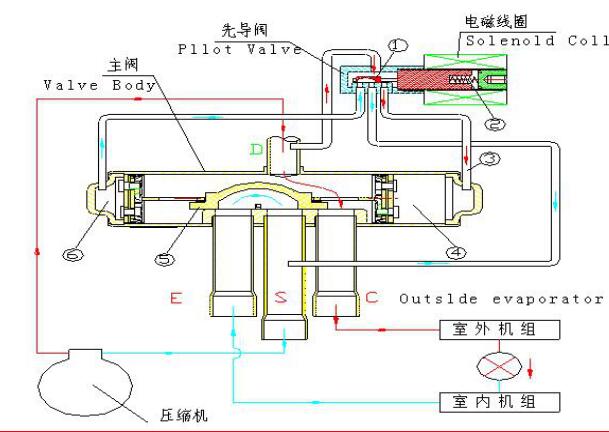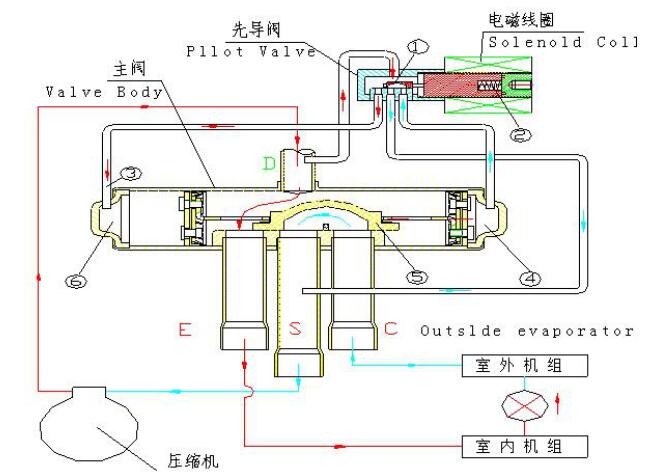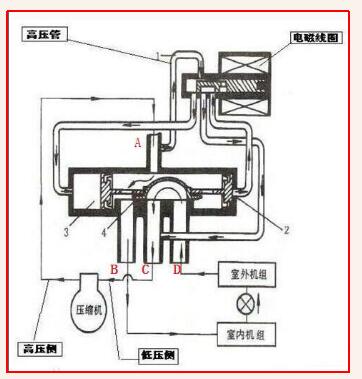Working principle of four-way valve
1. Refrigeration cycle (coil power-off state)
When the solenoid coil is in the de-energized state (ie, refrigerating state), the pilot slide valve â‘ is driven by the compression spring â‘¡ to move to the left, and the high-pressure fluid enters the capillary â‘¢ and then enters the right piston chamber â‘£.
On the other hand, the fluid in the left piston chamber ⑥ is connected to the S tube and discharged by the suction of the compressor; the pressure difference between the two ends of the piston is generated, the piston and the main slide valve ⑤ move to the left, so that the E and S takeovers are connected, D, C takes over and communicates, so a refrigeration cycle is formed, and the flow of refrigerant is shown in the figure.

2. Heating cycle (the coil is energized)
When the solenoid coil is in the energized state (ie heating state), the pilot slide valve â‘ overcomes the elastic force of the compression spring â‘¡ and moves to the right under the magnetic force generated by the solenoid coil. The high-pressure fluid enters the capillary â‘¢ and then enters the left piston cavity â‘¥.
On the other hand, the fluid in the right piston chamber ④ is connected to the S pipe and is sucked by the compressor and discharged; the pressure difference between the two ends of the piston is generated, and the piston and the main slide valve ⑤ move to the right, so that the C and S takeover pipes communicate, D, E takes over and communicates, so a heating cycle is formed, and the flow of refrigerant is shown in the figure.

1. Refrigeration
When the air conditioner is in the refrigerating state, the four-way valve is not energized, the four-way valve is in the state of AD and BC. The refrigerant is compressed by the compressor and converted into high-temperature and high-pressure gas, which passes through the A port of the four-way valve and is discharged from the D port. Entering the outdoor heat exchanger (condenser), it becomes a medium-temperature and high-pressure liquid after the condenser absorbs heat and releases heat. After passing through the expansion valve, it becomes a low-temperature and low-pressure liquid, and passes through the indoor heat exchanger (evaporator) to absorb heat and release cold. After the action, it becomes a low-temperature and low-pressure gas, passes through port B of the four-way valve, returns to the compressor from port C, and then continues to circulate.

2. Heating
When the air conditioner is in the heating state, the four-way valve is energized and the piston moves to the right to connect AB and CD. The refrigerant is compressed by the compressor and converted into high-temperature and high-pressure gas, which passes through the A port of the four-way valve and is discharged from the B port. Entering the indoor heat exchanger (condenser), it becomes a medium-temperature and high-pressure liquid after the condenser absorbs heat and releases heat, and then becomes a low-temperature and low-pressure liquid after passing through the expansion valve, and passes through the outdoor heat exchanger (evaporator) to absorb heat and release cold. After that, it becomes a low-temperature and low-pressure gas, passes through port D of the four-way valve, returns to the compressor from port C, and then continues to circulate.

MW02 Smart Watch
MW02 Smart Watch
everyone enjoys luck , https://www.eeluckwatch.com